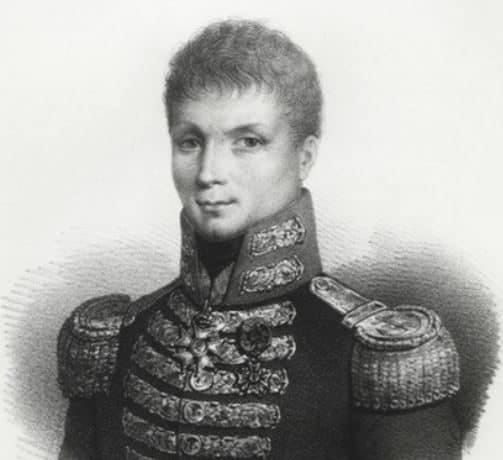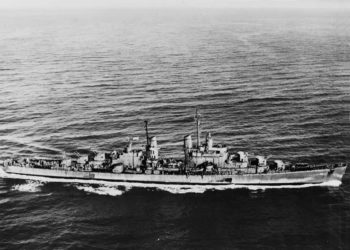Captain Lucas: A French Badass
 Jean Jacques Étienne Lucas joined the French Navy in 1778. He was 14. From 1779 onward, he served onboard L’Hermione as a Quartermaster’s Mate.
Jean Jacques Étienne Lucas joined the French Navy in 1778. He was 14. From 1779 onward, he served onboard L’Hermione as a Quartermaster’s Mate.
The Early Years and American Revolutionary War
L’Hermione is famous for being the ship that ferried French General LaFayette to the United States in 1780 in support of the rebels in the American Revolutionary War. In 1781, Étienne Lucas got his first taste of battle against the Royal Navy and won his first scar (on his left wrist).
Captain of the Redoutable
By 1805, Lucas was a captain and was the commander of the ship of the line Redoutable. As a captain, he was obsessed with drills: His men were taught how to sweep a gun’s deck with musket fire and grenades and had to train daily with swords, pistols, muskets, and grappling hooks.
Launched as Suffren in 1791, the Redoutable (renamed as such in 1794) was a French Temeraire class 3rd rate ship of the line (74 guns). She served in the Caribbean before taking part in the Battle of Trafalgar in 1805. There, she was the 4th ship in the French line behind their flagship Bucentaure.
The Battle of Trafalgar
During the Battle of Trafalgar, as Nelson attempted to cross the French line, the two French ships behind the Bucentaure dropped behind, exposing the flagship’s stern. Fearing that HMS Victory could edge behind Bucentaure and rake her, Captain Lucas sailed Redoutable forward and attempted to close the gap. Redoutable found herself facing off with Victory.
The odds were not in favour of the French ship: She was a 2-deck 74 guns 3rd rate and was now faced with a 104 guns 1st rate! Nevertheless, Redoutable opened fire, unleashing a withering 10-minute barrage aimed at Victory’s rigging in an attempt to disable her. Victory’s foremast tops, mizzen, and main topgallant ended up damaged, but her momentum brought her up against Redoutable. Both ships became entangled.
The Face-Off and Boarding Attempt
Lucas had relentlessly prepared his men for just this scenario and Redoutable had a sizeable infantry corps on board: 100 Frenchmen unleashed a 15-minute musket volley barrage on Victory, throwing an estimated 200 grenades on its decks for good measure. Victory’s Castle and Quarterdeck were soon covered with dead and wounded British sailors, to a point where the Brits stopped returning fire. It was during this exchange that Nelson was mortally wounded.
Sensing that he had the initiative, Lucas ordered his men to try and board Victory. However, this was not an easy task as Victory’s freeboard was higher than Redoutable’s own. The French were about to board Victory when HMS Temeraire, a 98 guns 2nd rate, pulled alongside Redoutable and opened fire at point-blank range, killing and wounding scores of French sailors. The ordeal wasn’t over for Redoutable, as HMS Tonnant, an ex-French 80 guns ship, came alongside, too.
The Fierce Battle and Ultimate Surrender
Redoutable was now engaged in an artillery duel, at point-blank range, against three ships, all bigger than her. Lucas himself was wounded but refused to give in. The French cannon crews worked so hard that two of Redoutable’s guns overheated and exploded, killing and wounding nearby sailors and gun crews.
The initial engagement started at around 12 noon. Redoutable and Victory started their Face-Off at around 12:45. Captain Lucas only struck his colours at 14:30 when Redoutable was threatening to sink and he was left with only 99 able men out of a crew of 643 men. His ship had suffered 300 dead and 222 men severely wounded during the engagement. Victory sustained 160 casualties during the battle, many of those inflicted by Redoutable. Temeraire suffered 120 casualties during the fight.
Don’t think, however, that Captain Lucas was easier to deal with once he had struck his colours: As Redoutable and Temeraire were still entangled, he threatened to burn his ship and take the Royal Navy ship down alongside his own, unless the British sent men to man the pumps of his ships to try and keep her afloat!
The Aftermath and Legacy
Redoutable was taken in tow by HMS Swiftsure the next day, but the French ship was dying. Lucas signalled for help and Swiftsure sent men and boats to evacuate her, but it was too late: She sank, taking with her 196 men. Most of those were men severely wounded during the fighting the previous day. They could not move on their own. Captain Lucas was taken prisoner in England where he was treated with great respect and courtesy. Upon his release and return to France, he was awarded the title of Commandeur of the Legion of Honour by Napoleon himself. Captain Lucas was a French Badass… And the Royal Navy would soon face him at sea all over again!









